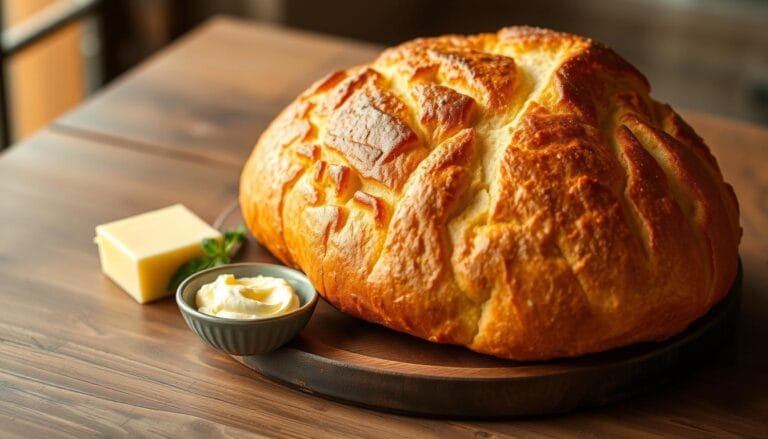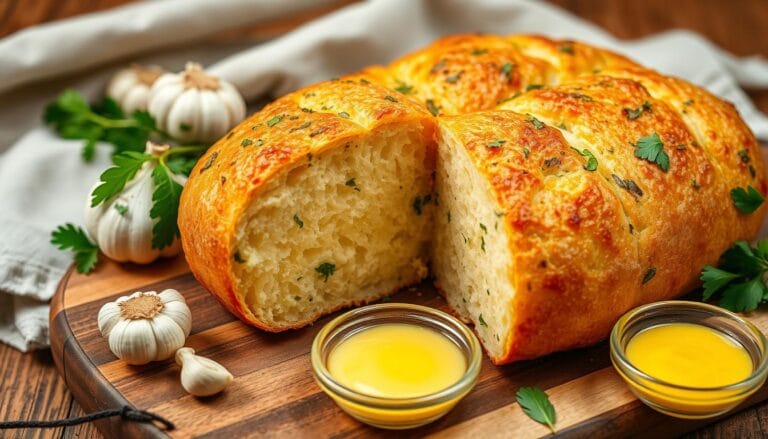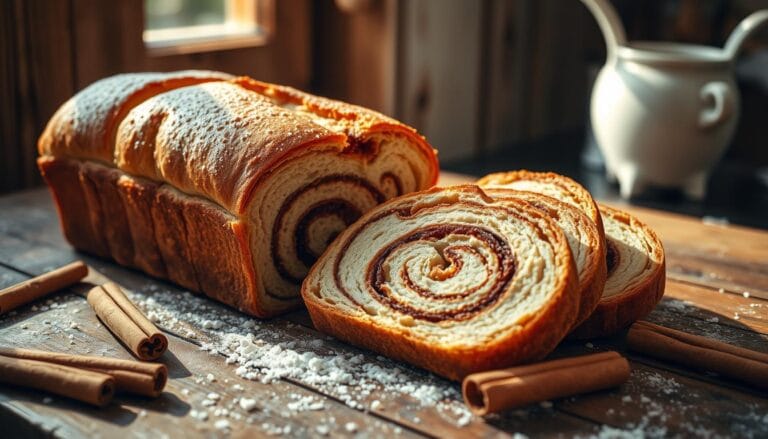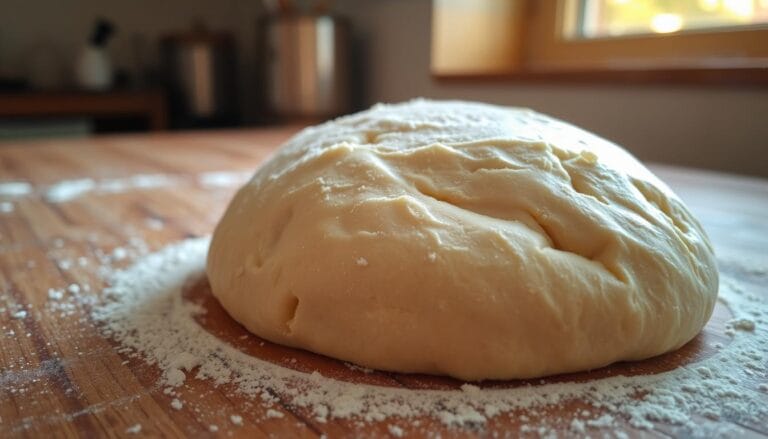The Full Homemade Ciabatta Bread Guide
I still remember the first time I bit into a freshly baked ciabatta bread. The crispy crust gave way to a soft, airy interior. It left me wanting more. Ciabatta bread is a classic Italian-style bread made from just 4 main ingredients: flour, yeast, water, and salt.
With its unique texture and flavor, it’s no wonder ciabatta bread is loved by many. It’s a staple in Italian households and a favorite among homemade bread enthusiasts.
Over the past few months, I’ve made and tested at least 15 batches of ciabatta bread. I’ve refined my technique and learned what makes this bread special. The process of making ciabatta bread is a labor of love.
It requires patience, dedication, and a willingness to learn. With this guide, I hope to share my knowledge and passion for ciabatta bread with you. I want to help you create your own delicious homemade ciabatta bread.
Whether you’re a seasoned baker or just starting out, this guide will help you. We’ll cover the process of making ciabatta bread, from the initial ingredients to the final bake. We’ll talk about the essential tools and equipment you’ll need.
We’ll also explore the science behind the dough and the techniques for creating those signature air pockets and a crispy crust. So, let’s start this journey to create the perfect homemade ciabatta bread. It’s a true artisan bread that’s sure to impress your friends and family.
Table of Contents
The Rich History Behind Traditional Ciabatta Bread
Ciabatta bread has a rich history that started in the 1980s in Northern Italy. The name “ciabatta” means “slipper” in Italian, which suits its shape and texture. It was made to compete with French baguettes, and now we have many types, like sourdough and lions bread.
Arnaldo Cavallari, an Italian baker, created the Ciabatta Polesano in 1982. He made it to fight off French baguettes’ popularity in Italy. Since then, ciabatta has become a favorite worldwide, including in the UK, where Marks & Spencer introduced it in 1985.
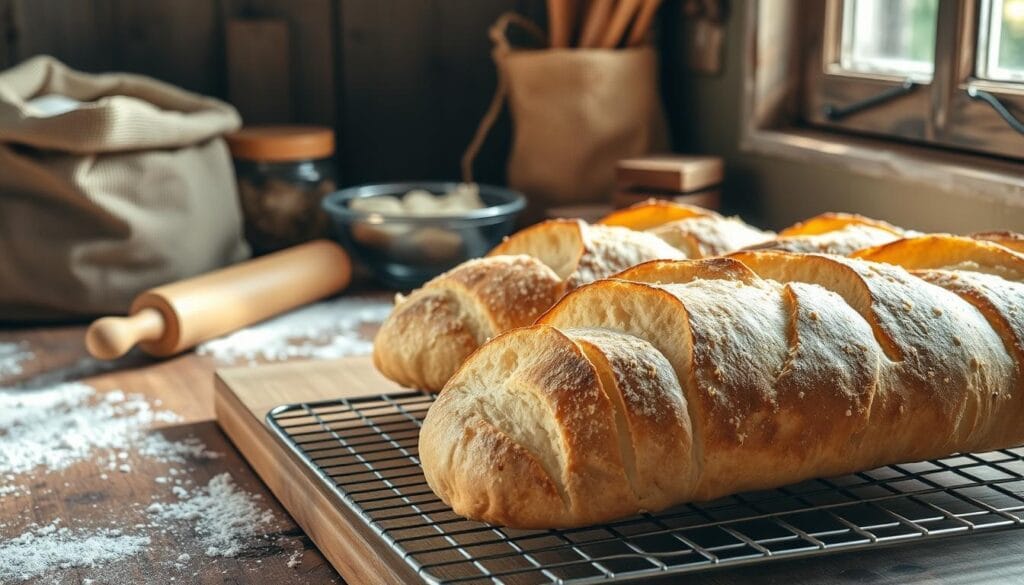
- Ciabatta bread was first launched in Britain in 1985, marking the beginning of its popularity in British supermarkets.
- By the time of the 1990 FIFA World Cup in Italy, ciabatta had become one of the most popular ‘exotic’ foods in Britain.
- Cavallari’s firm, Molini Adriesi, now licenses production of ciabatta in 11 different countries.
Ciabatta bread has grown in popularity since its creation. Its unique taste and texture make it a favorite, whether you go for the traditional recipe or try sourdough or lions bread.
Essential Tools and Equipment for Perfect Ciabatta
To make perfect ciabatta bread, you need the right tools and equipment. As a home baker, I know that having the right items can greatly improve your bread’s quality. In a bakery, you’d find a stand mixer, a baking stone, and a dough scraper as key tools for making rustic and olive oil bread.
Here are some essential tools and equipment you’ll need to start:
- Stand mixer: This helps mix and knead the dough, making it easier to develop the gluten in the bread flour.
- Baking stone: It’s used to bake the bread, giving it a crispy crust like a traditional bakery.
- Dough scraper: This tool makes it easier to handle the dough by scraping it off the counter and into a bowl or onto a baking sheet.
You’ll also need a few more items, like a measuring cup, a wooden spoon, and a clean work surface. With these tools, you’ll be on your way to making perfect ciabatta bread, whether it’s rustic or olive oil bread.

Investing in the right tools and equipment will help you make high-quality bread, just like a professional bakery. Whether you’re an experienced baker or just starting, the right equipment can make a huge difference. So, why not start today and see what you can create?
Understanding the Science of Ciabatta Dough
To make a tasty ciabatta bun, knowing the science behind the dough is key. It combines flour, water, yeast, and salt. This mix might seem simple, but the chemistry is complex. The flour’s protein content is crucial for the dough’s strength and stretchiness.
For a no knead ciabatta, this is even more important. It relies on yeast fermentation.
When making a baguette recipe, the dough’s hydration is vital. Ciabatta needs about 75% water or more. This makes the dough light and easy to digest.
The long fermentation process also helps. It breaks down wheat’s fructans, making it better for those with sensitivities. Plus, it makes each slice less calorie-dense, helping you feel full without eating too much.
Protein Content and Gluten Development
The flour’s protein content is key for ciabatta’s texture. Flour with 12.5-14.0% protein is best. This, along with the right water, makes a delicious ciabatta bun.

The Role of Hydration
Hydration is crucial for ciabatta dough. It impacts yeast activity and the bread’s texture. Aim for about 80% hydration. This helps enzymes in the flour unlock nutrients like magnesium and B vitamins.
Temperature Control Importance
Temperature control is vital in making ciabatta. It affects yeast fermentation and the bread’s texture. Bulk fermentation should be around 73-74 °F. Proofing is best at 77-86 °F, with 60-70% relative humidity (RH).
Mastering the Art of Ciabatta Bread: Step-by-Step Process
To make ciabatta bread, you need to mix, knead, and bake. This method works for farmhouse on boone ciabatta and homemade bread too.
Start by mixing flour, yeast, salt, and water. You can use a stand mixer or do it by hand. Let the mixture rest for a few minutes to soak the flour.
Then, knead the dough for 10-15 minutes. It should become smooth and elastic. You can use a stand mixer or knead by hand. Place the dough in a lightly oiled bowl, cover it, and let it rise in a warm place for 1-2 hours.
After rising, punch down the dough and shape it into a long, thin loaf. Put it in a dutch oven bread basket or on a baking sheet with parchment paper. Let it rise for another 30-60 minutes.

Preheat your oven to 425°F (220°C). Bake the ciabatta for 15-20 minutes, until it’s golden brown and hollow when tapped. Let it cool on a wire rack for 10-15 minutes before slicing.
Here’s how to make ciabatta bread:
* Mix flour, yeast, salt, and water.
* Knead the dough for 10-15 minutes.
* Let it rise in a warm place for 1-2 hours.
* Punch down and shape into a long, thin loaf.
* Let it rise again for 30-60 minutes.
* Bake at 425°F (220°C) for 15-20 minutes, until golden brown and hollow.
The Secret to Achieving Those Signature Air Pockets
To get those air pockets in ciabatta bread, you need to know about folding, fermentation, and crumb structure. A good recipe, like sourdough or lions bread ciabatta, will show you how.
Folding the dough creates layers and air pockets. This makes the bread light and airy. Managing fermentation time is key, as it lets yeast make carbon dioxide and air pockets.
Proper Folding Techniques
- Fold the dough gently to avoid deflating it
- Fold the dough at regular intervals to create even layers
- Use a bench scraper to handle sticky dough during shaping
Fermentation Time Management
The best time for biga fermentation is 12-24 hours. Let the dough rest for 30-45 minutes after shaping. The whole process takes about 4 hours and 55 minutes.

Creating the Perfect Crumb Structure
High hydration is key for a light, airy crumb. The dough needs 2 cups of lukewarm water and 5-6 cups of flour, based on humidity. Follow these steps and use a good recipe to make a delicious ciabatta with air pockets.
Common Mistakes to Avoid in Ciabatta Making
Making ciabatta bread can be tricky. Common mistakes like overmixing, underproofing, and overbaking can ruin the texture and taste. As someone who loves making artisan bread, I’ve learned these errors can make the bread dense, tough, or dry.
To steer clear of these mistakes, it’s important to stick to a recipe and watch your dough and bread closely. Here are some mistakes to avoid:
- Overmixing the dough, which can lead to a dense and tough ciabatta bread
- Underproofing the dough, resulting in a bread that’s not fully risen
- Overbaking the bread, causing it to become dry and crumbly
By being careful, you can make a delicious, authentic artisan bread. Use top-notch ingredients like King Arthur flour. Also, make sure to let the dough rest and rise for the right time.
With time and effort, you’ll get better at making ciabatta bread. It might not be perfect at first, but keep trying. Soon, you’ll impress everyone with your ciabatta skills.

Advanced Techniques for Professional-Style Results
To get professional-style ciabatta bread, you need advanced techniques. These include pre-fermentation, double hydration, and mastering temperature control. These methods enhance the bread’s flavor and texture, making it more complex.
Pre-fermentation is key in making ciabatta. It lets the dough ferment before baking. This step boosts the bread’s flavor and texture. For example, sourdough ciabatta gets its tangy taste from a natural starter.

The double hydration technique is another method used. It involves two hydration steps for a richer flavor. This technique makes the bread tender and flavorful. With these techniques, your ciabatta will have a crispy crust and a soft inside, just like Italian bakeries.
Pre-fermentation Methods
- Allowing the dough to ferment for a certain amount of time before baking
- Using a natural starter culture to ferment the dough
- Creating a more complex and nuanced flavor profile
Double Hydration Technique
- Using two separate hydration steps to create a more complex and nuanced flavor profile
- Developing the flavor and texture of the bread
- Resulting in a more tender and flavorful crumb
Creating the Perfect Crust: Tips and Tricks
To get a perfect crust on your ciabatta bread, try using a baking stone. It makes the crust crispy and golden. Another trick is steam injection, which makes the crust crispy outside and soft inside. Scoring the bread right can also help it bake evenly, making the crust look great.
When baking Italian bread like ciabatta, a good crust is key. It affects the bread’s texture and taste. Here are some tips for a perfect crust:
- Use a baking stone to create a crispy and well-browned crust
- Steam injection to create a crust that is crispy on the outside and chewy on the inside
- Proper scoring to control the way the bread expands during baking
As someone who loves making artisan bread, I know making the perfect crust takes time. But with the right methods and tools, you can get a crust that’s tasty and looks good. Whether it’s ciabatta or other artisan bread, aim for a crust that’s crispy, golden, and flavorful.

Follow these tips to make your ciabatta bread’s crust perfect. Don’t be afraid to try new things and see what works for you. Happy baking!
Variations of Traditional Ciabatta Bread
Ciabatta bread has changed a lot since it was first made in Italy in 1982. One popular change is the whole wheat ciabatta. It uses whole wheat flour for a nuttier taste. Another twist is the olive and herb-infused ciabatta, which adds a savory flavor.
For a tangy taste, try the sourdough version of ciabatta. It uses a sourdough starter instead of commercial yeast. These variations follow a similar process to the traditional recipe but with some tweaks.
For example, you can use a no knead ciabatta recipe to make a whole wheat version. Or, adapt a baguette recipe to include olives and herbs. The key is to try different ingredients and techniques to find unique flavors. Whether you like the classic ciabatta or something new, there’s a recipe for you.
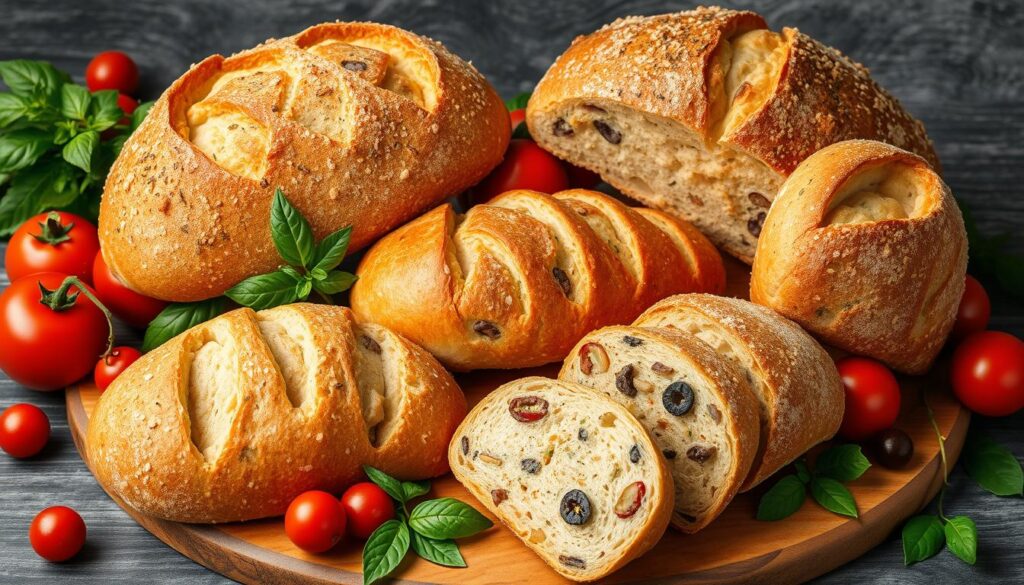
- Garlic and rosemary ciabatta
- Sun-dried tomato ciabatta
- Spinach and feta ciabatta
These variations can give the traditional ciabatta a fresh twist. They offer a tasty and flavorful bread option for any time.
Storing and Refreshing Your Ciabatta
To keep your homemade ciabatta bread fresh, you have a few options. Freezing is a great choice. Just wrap the bread tightly in plastic wrap or foil and freeze for up to 3 months. You can also refrigerate it for up to 5 days by wrapping it tightly.
Refreshing your ciabatta bread can also help. Place it in a low-temperature oven (around 200°F) for 5-10 minutes. This method is perfect for farmhouse on boone ciabatta and dutch oven bread, as it brings back the bread’s natural texture and flavor.
Here are some tips for storing and refreshing your homemade ciabatta bread:
- Freeze the bread for up to 3 months
- Refrigerate the bread for up to 5 days
- Refresh the bread in a low-temperature oven for 5-10 minutes
By following these tips, you can enjoy your homemade ciabatta bread for longer. Whether it’s a classic ciabatta or a variation like farmhouse on boone ciabatta or dutch oven bread, proper storage and refreshing methods keep it fresh and flavorful.
Pairing Your Homemade Ciabatta: Serving Suggestions
Now that you’ve learned to make homemade ciabatta, it’s time to think about how to serve it. A classic ciabatta recipe pairs well with traditional Italian flavors like olive oil, tomatoes, and basil. You can also enjoy it with cured meats and cheeses for a tasty snack.
For something new, use your lions bread ciabatta for sandwiches and paninis. Fill it with roasted veggies, meats, and cheeses. It’s also great for dipping in soups, stews, and salads, adding variety to any meal.
- Bruschetta with fresh tomatoes and basil
- Caprese sandwiches with mozzarella, tomato, and basil
- Paninis with assorted meats and cheeses
- Dipping bread for soups and stews
Homemade ciabatta is a must-have in your kitchen. It’s perfect for both traditional and modern pairings. So, get creative and enjoy your homemade ciabatta with your favorite dishes!
Troubleshooting Your Ciabatta Problems
Making ciabatta bread can sometimes lead to issues like a dense or tough crumb. Or, the crust might not be crispy. To fix these problems, it’s key to check the yeast, temperature, and how much water you use. These factors greatly impact the bread’s texture and taste.
Sticky dough is a common issue with ciabatta. It often happens because of too much water or the wrong type of flour. Flour with a protein content of 12% or more is better for handling dough. For example, Robin Hood’s all-purpose flour has 13.2% protein, making it great for ciabatta.
To get the right dough consistency, pay attention to the water to flour ratio. For 500g of flour, use 350g of water for 70% hydration. If you want 65% hydration, use 25g less water, aiming for 325g. This careful approach can help you achieve the perfect crumb in your artisan bread.
- Checking the yeast to ensure it’s active and healthy
- Verifying the temperature to ensure it’s within the ideal range
- Adjusting hydration levels to achieve the perfect balance
By following these tips and using top-notch ingredients, like italian bread flour, you can make delicious ciabatta bread. It will be just as good as any you buy from a store.
Seasonal Adjustments for Perfect Results
When making ciabatta bread, it’s key to think about the season. The recipe can change with temperature and humidity. To get the best crust and crumb, knowing how to adjust for each season is crucial.
In summer, the dough might rise too fast, making it dense. To fix this, bake in a cooler spot and for a shorter time. Winter’s cold can slow down rising, so use warmer spots and longer times.
Summer Baking Modifications
In summer, cut down the liquid in the recipe by about 10%. This keeps the dough right. Also, use cooler water to keep the dough at 75°F to 78°F.
Winter Temperature Considerations
In winter, use warmer temperatures for rising. Aim for 75°F to 78°F. You can use warmer water or a proofing box to achieve this.
Knowing how to adjust for the season ensures your ciabatta is perfect all year. Whether you’re making traditional or sourdough ciabatta, these tips will help you get it right.
Your Journey to Artisan Bread Mastery Starts Here
Becoming a master of artisan bread, like the famous ciabatta, takes patience, practice, and persistence. Crafting the perfect Italian bread like ciabatta is an art. Each step is key to getting those air pockets and a lightly crisp crust.
At DLM Artisan Bread, our bakers have over 150 years of experience. They’ve worked hard to perfect artisan bread making. With their help and the techniques in this guide, you can start your own bread-making journey. Every loaf you bake brings you closer to your own unique style and flavor.
FAQ
What is ciabatta bread and what are its characteristics?
What are the essential ingredients and tools needed to make ciabatta bread?
How does the science behind ciabatta dough work?
What is the step-by-step process for making ciabatta bread?
What is the secret to achieving the signature air pockets in ciabatta bread?
What are some common mistakes to avoid when making ciabatta bread?
What are some advanced techniques for achieving professional-style results when making ciabatta bread?
How can I achieve the perfect crust when making ciabatta bread?
What are some variations of traditional ciabatta bread that I can try?
How can I store and refresh my homemade ciabatta bread?
Leave a Review
There are no reviews yet. Be the first one to write one.


